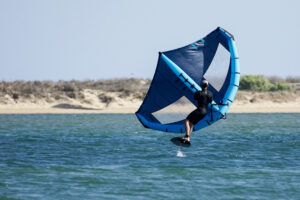WHAT IS FOILING?
Author: Jon Mann
Hydrofoiling or foiling as its most commonly referred to is taking over the water sports world with kiting, wake surfing, wind surfing, SUP and surfing all having growing foil disciplines as well as the rapid growth of wing foiling and efoiling. So what is a hydrofoil? A hydrofoil is effectively a wing that ‘flies’ under the surface of the water, allowing the user to ride a board above the water’s surface.
So why would you want to ride a foil? Well, it’s fun! Foils are incredibly efficient and therefore facilitate riding in more marginal conditions. In kite foiling and wind foiling, this means you can ride in lighter wind without having to rig huge kites and sails, and in SUP and surf foiling it means you can ride on waves you never would be able to surf normally. All in all it increases the envelope of rideable conditions.


WHAT GEAR DO I NEED?
With the current rate of development, foil gear can be overwhelming with all the options that are available. Foils are made up of the following parts (see picture below taken from the AK Durable Supply Co. site):
Mast + Base plate: Aluminium masts come with base plates to mount them on the board and carbon masts typically are 1 piece. When you are starting out, a shorter mast (45-65cm) is recommended as it is easier to control the pitch of the board and also more forgiving in the event that you breach (when you’re foil comes out the water).
Fuselage: This is what connects the foil wings to the mast. The longer your fuselage is, the more stable the foil will be. Pump frequency is also affect by fuselage length with longer fuselages requiring a slower cadence and shorter fuselages requiring a faster cadence. Shorter fuselages tend to also be snappier and more responsive.
Front wing: Front wings come in various shapes and sizes. as this is a general overview, sizes wont be discussed (will be discussed in each disciplines page, as this varies by discipline). Shape however plays a more important role. The main characteristic to consider is aspect ratio. Aspect ratio (AR) is the ratio between the wing span (tip to tip) and the chord (front to back). A higher AR (think glider plane) will give you a foil that glides and pumps really well but doesn’t turn as well. A lower AR will give you a foil that has good low speed lift, turns well and is stable.
Rear wing: The rear wing is also referred to as the stabilizer, most brands will recommend which rear wing to select (if there are options) to match your selected front wing. Rear wings can drastically change the behavior of a foil. Rear wings can also be shimmed to change their angle of attack relative to the front wing, again changing the performance of the foil.

HOW DO I LEARN TO FOIL?
There are a number of ways to get into foiling. If you’re a good kiter, I’d say to start with kite foiling, and for other disciplines the best way to ease your way into foiling is either behind a boat or at a cable park with a two tower system. A boat or at a two tower cable park will provide a constant pull allowing you to get a feel for riding a hydrofoil without worrying about the kite / wing / wave..
The way that I got into foiling was to lean the water start on the kite before then going to a two tower cable park to really get the hang of riding the foil board, pumping and turning without having to worry about the kite. For me this was extremely successful and after one kite session, and 3 x 20mins at the cable park, I found myself able to foil super comfortably and jibe with no issues due to my increased board riding confidence gained at the cable park.